Prominent Academicians of the early 17th century, such as Andrea Sacchi, felt that genre and still-life painting did not carry the “gravitas” merited for painting to be considered great. An influential formulation of 1667 by André Félibien, a historiographer, architect and theoretician of French classicism became the classic statement of the theory of the hierarchy of genres for the 18th century:

Celui qui fait parfaitement des païsages est au-dessus d’un autre qui ne fait que des fruits, des fleurs ou des coquilles. Celui qui peint des animaux vivants est plus estimable que ceux qui ne représentent que des choses mortes & sans mouvement ; & comme la figure de l’homme est le plus parfait ouvrage de Dieu sur la Terre, il est certain aussi que celui qui se rend l’imitateur de Dieu en peignant des figures humaines, est beaucoup plus excellent que tous les autres …
He who produces perfect landscapes is above another who only produces fruit, flowers or seafood. He who paints living animals is more estimable than those who only represent dead things without movement, and as man is the most perfect work of God on the earth, it is also certain that he who becomes an imitator of God in representing human figures, is much more excellent than all the others …”.

Dutch and Flemish painting
Still life developed as a separate category in the Low Countries in the last quarter of the 16th century. The English term still life derives from the Dutch word stilleven while Romance languages (as well as Greek, Polish, Russian and Turkish) tend to use terms meaning dead nature. 15th-century Early Netherlandish painting had developed highly illusionistic techniques in both panel painting and illuminated manuscripts, where the borders often featured elaborate displays of flowers, insects and, in a work like the Hours of Catherine of Cleves, a great variety of objects. When the illuminated manuscript was displaced by the printed book, the same skills were later deployed in scientific botanical illustration; the Low Countries led Europe in both botany and its depiction in art. The Flemish artist Joris Hoefnagel (1542–1601) made watercolour and gouache paintings of flowers and other still-life subjects for the Emperor Rudolf II, and there were many engraved illustrations for books (often then hand-coloured), such as Hans Collaert’s Florilegium, published by Plantin in 1600.
Around 1600 flower paintings in oils became something of a craze; Karel van Mander painted some works himself, and records that other Northern Mannerist artists such as Cornelis van Haarlem also did so. No surviving flower-pieces by them are known, but many survive by the leading specialists, Jan Brueghel the Elder and Ambrosius Bosschaert, both active in the Southern Netherlands.
While artists in the North found limited opportunity to produce the religious iconography which had long been their staple—images of religious subjects were forbidden in the Dutch Reformed Protestant Church—the continuing Northern tradition of detailed realism and hidden symbols appealed to the growing Dutch middle classes, who were replacing Church and State as the principal patrons of art in the Netherlands. Added to this was the Dutch mania for horticulture, particularly the tulip. These two views of flowers—as aesthetic objects and as religious symbols— merged to create a very strong market for this type of still life. Still life, like most Dutch art work, was generally sold in open markets or by dealers, or by artists at their studios, and rarely commissioned; therefore, artists usually chose the subject matter and arrangement. So popular was this type of still-life painting, that much of the technique of Dutch flower painting was codified in the 1740 treatise Groot Schilderboeck by Gerard de Lairesse, which gave wide-ranging advice on colour, arranging, brushwork, preparation of specimens, harmony, composition, perspective, etc.
The symbolism of flowers had evolved since early Christian days. The most common flowers and their symbolic meanings include: rose (Virgin Mary, transience, Venus, love); lily (Virgin Mary, virginity, female breast, purity of mind or justice); tulip (showiness, nobility); sunflower (faithfulness, divine love, devotion); violet (modesty, reserve, humility); columbine (melancholy); poppy (power, sleep, death). As for insects, the butterfly represents transformation and resurrection while the dragonfly symbolizes transience and the ant hard work and attention to the harvest.
Flemish and Dutch artists also branched out and revived the ancient Greek still life tradition of trompe-l’œil, particularly the imitation of nature or mimesis, which they termed bedriegertje (“little deception”). In addition to these types of still life, Dutch artists identified and separately developed “kitchen and market” paintings, breakfast and food table still life, vanitas paintings, and allegorical collection paintings.
In the Catholic Southern Netherlands the genre of garland paintings was developed. Around 1607–1608, Antwerp artists Jan Brueghel the Elder and Hendrick van Balen started creating these pictures which consist of an image (usually devotional) which is encircled by a lush still life wreath. The paintings were collaborations between two specialists: a still life and a figure painter. Daniel Seghers developed the genre further. Originally serving a devotional function, garland paintings became extremely popular and were widely used as decoration of homes.
A special genre of still life was the so-called pronkstilleven (Dutch for ‘ostentatious still life’). This style of ornate still-life painting was developed in the 1640s in Antwerp by Flemish artists such as Frans Snyders and Adriaen van Utrecht. They painted still lifes that emphasized abundance by depicting a diversity of objects, fruits, flowers and dead game, often together with living people and animals. The style was soon adopted by artists from the Dutch Republic.
Especially popular in this period were vanitas paintings, in which sumptuous arrangements of fruit and flowers, books, statuettes, vases, coins, jewelry, paintings, musical and scientific instruments, military insignia, fine silver and crystal, were accompanied by symbolic reminders of life’s impermanence. Additionally, a skull, an hourglass or pocket watch, a candle burning down or a book with pages turning, would serve as a moralizing message on the ephemerality of sensory pleasures. Often some of the fruits and flowers themselves would be shown starting to spoil or fade to emphasize the same point.
 Cornelis Norbertus Gysbrechts (c. 1660–1683), Trompe l’oeil (c. 1680), Los Angeles County Museum of Art |
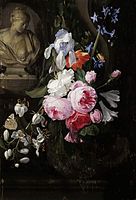 Jan Philip van Thielen (1618–1667), Vase of Flowers (c. 1660), Fitzwilliam Museum, Cambridge, England |
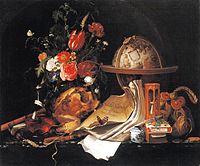 Maria van Oosterwijk, Vanitas-Still Life (1693) |
 Jan Jansz. Treck (1606–1652), Still Life Pewter Jug and Two Porcelain Plates (1645) |
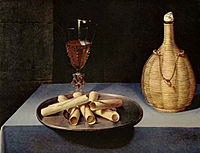 Lubin Baugin (c. 1610-1663), Le Dessert de gaufrettes (c. 1631), Musée du Louvre, Paris |
|---|
Another type of still life, known as ontbijtjes or “breakfast paintings”, represent both a literal presentation of delicacies that the upper class might enjoy and a religious reminder to avoid gluttony. Around 1650 Samuel van Hoogstraten painted one of the first wall-rack pictures, trompe-l’œil still-life paintings which feature objects tied, tacked or attached in some other fashion to a wall board, a type of still life very popular in the United States in the 19th century. Another variation was the trompe-l’œil still life depicted objects associated with a given profession, as with the Cornelis Norbertus Gysbrecht’s painting “Painter’s Easel with Fruit Piece”, which displays all the tools of a painter’s craft. Also popular in the first half of the 17th century was the painting of a large assortment of specimens in allegorical form, such as the “five senses”, “four continents”, or “the four seasons”, showing a goddess or allegorical figure surrounded by appropriate natural and man-made objects. The popularity of vanitas paintings, and these other forms of still life, soon spread from Holland to Flanders and Germany, and also to Spain and France.
The Netherlandish production of still lifes was enormous, and they were very widely exported, especially to northern Europe; Britain hardly produced any itself. German still life followed closely the Dutch models; Georg Flegel was a pioneer in pure still life without figures and created the compositional innovation of placing detailed objects in cabinets, cupboards, and display cases, and producing simultaneous multiple views.
Dutch, Flemish, German and French paintings
 Peter Paul Rubens, Diana Returning from the Hunt, still life elements by a specialist (c. 1615) |
 Rembrandt, Still-Life with Two Dead Peacocks and a Girl (c. 1639) |
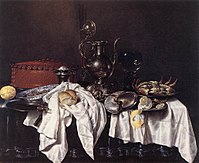 Willem Claeszoon Heda (1594–1680), Still Life with Pie, Silver Ewer and Crab (1658) |
 Ambrosius Bosschaert (1573–1621), Still-Life of Flowers (1614) |
|---|---|---|---|
 Samuel van Hoogstraten, Feigned Letter Rack with Writing Implements (c. 1655) |
 Pieter Boel (1626–1674), Still Life with a Globe and a Parrot (c. 1658) |
 Pieter Claesz (c.1597–1660), Still Life (1623) |
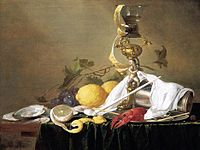 Jan Davidsz. de Heem (1606–1684), Still Life with Fruit, Flowers, Glasses and Lobster (c. 1660s) |
 Peter Binoit, 1618, Skokloster Castle. |
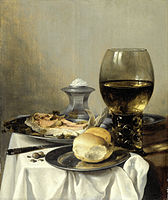 Pieter Claesz (c. 1597–1660), Still Life with Salt Tub |
 Osias Beert the Elder, Dishes with Oysters, Fruit, and Wine |
 George Flegel (1566–1638), Still-Life with Bread and Confectionery, 1630 |
Source From Wikipedia
